I have decided to play all the games in the Ganbare Goemon series.. reasoning unclear. Not sure how much I’ll have to say about each, so these are less ‘reviews‘, and more ‘the impressions a video game leaves as it washes over me‘. I’ll probably have more to say about some than others, but in any case I’m still treating this whole thing like a big ‘ole event.

All the hard work is done already; identify your enemies, then attack. There are currently ~34 games in the series, including spin-offs, and I’ll be playing what I’m able to, 25 of ’em. Since this is quite a large undertaking, I’ll be splitting this journey up into 5 parts. Today we’ll cover:
- Mr. Goemon (1986) (ARCADE)
- Ganbare Goemon! Karakuri Dōchū (1986) (NES)
- Ganbare Goemon 2 (1989) (NES)
- Ganbare Goemon Gaiden: Kieta Ōgon Kiseru (1990) (NES)
- Ganbare Goemon: Yukihime Kyuushutsu Emaki (1991) (SNES)
The 9ish games we won’t be playing:
- Mini Kyodai Robo Goemon Compact (Mobile Phone Game)
- Ganbare Goemon Shishijūrokubē no Karakuri Manji Gatame (Mobile Phone Game)
- Ganbare Goemon: Ebisumaru Kiki Ippatsu (Handheld Electronic Game)
- Goemon Mononoke Sugoroku (Nintendo64 Sugoroku game with Goemon characters)
- Ganbare Goemon: Tsūkai Game Apli Series (Series of Mobile phone games from 2002-2003)
- Ganbare Goemon! Karakuri Douchuu: Machi Hen (Board game based on the first NES game THAT I WOULD TOTALLY PLAY but seems impossible to find)
- Ganbare Goemon (“Medal game”, a type of coin game you’d see at an arcade. Think like, that game you throw coins at and then pushes the coins at you)
- Ganbare Goemon Pachisuro 1 & 2 (Two different Pachislot games)
Not playing them for scarcity reasons, plus I heard some of the phone games don’t exist anymore and frankly can’t be bothered to do too much more research than that. I know, a real fan would import a Pachislot, I know.. I know… but, I’ve got my plate golden pipe full enough as is.

1) Mr. Goemon (1986) (ARCADE)
Not a lot to say about this one. The plot is, allegedly, that you’re trying to “stop demons by stealing the light on the Castle at Edo”, but your Great Thief status makes you a target for local ninjas after the bounty on your head.



It’s features 4 stages that cycle after you beat the final one. At the mid point of each stage you steal some money from a pile, smoke your pipe a bit, and check the map to see the way to the next town. Then you continue onto the the second half of the stage which ends with a boss. After beating the boss you’ll deliver the gold you just stole to the sleepy town, causing everyone’s lights to come on in.. joy, probably.
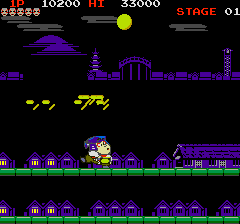


I like it as much as I like any arcade-game-for-points, I suppose. It’s not bad or great, and is very playable. I uh, don’t really know how to review an arcade game in this modern age of ours anyway.
2) Ganbare Goemon! Karakuri Dōchū (1986) (NES)
The first game with the Ganbare Goemon! title, “Go for it Goemon! A Tricky Journey”. The plot appears to be the same as the first game, trying to get to Edo to stop some demons. The goal of each area is to gather three BILLS which act as the passes to get you through the Checkpoint to the next section. There seems to always be 3 hidden bills somewhere on the map, either in hidden caves revealed by candles or jumping around, or in first-person 3D mazes. The game is also kind enough to include the option of just buying the bills, though the price increases which each consecutive bill. In between levels, Goemon is seen throwing money to the villagers behind the gate, just like in the arcade game.
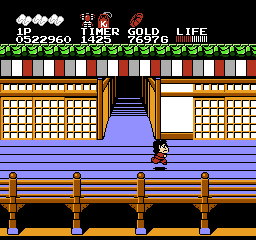
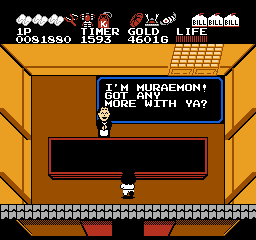

I noticed lots of elements in the later Goemon games that I’m already familiar with present here. Many of the enemy designs are the same, your weapon can upgrade from being just a pipe to throwing coins, you get money for touching maidens and lose money from hitting them, the terrible terrible 3D maze trend, using sandals to both increase your speed and the number of obstacle-tiles you can jump over, and the way armor and food works by absorbing damage or healing you when you hit 0 hp respectively.
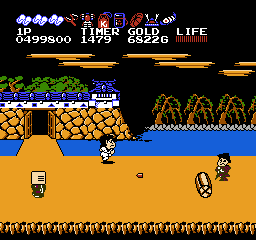

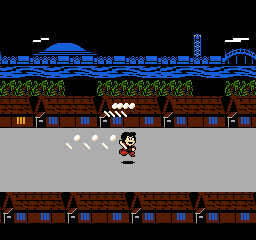
The biggest threat to my life in this game was the platforming and pitfalls. Falling into water, falling off mountains, slipping into pits, tumbling down holes. Whatever it was, if there was a tiny chance I could fall off the map, I’d find it. Everything else was pretty easy. You don’t lose any coins from the upgraded coin weapon like you do in later entries, so there was no downside to just blasting all the enemies from a distance.
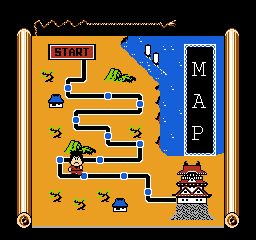

This game did it’s best to make you feel like you were going on a journey. One of the levels had you just moving to the right instead of exploring freely all around a town like the previous levels, so it really gave you the feeling of going someplace different, further away. I love how diverse the landscape is, clever use of the black background a lot of the tiles have to put things that ‘don’t belong’ in places without them looking too out of place. It was a pretty experience.
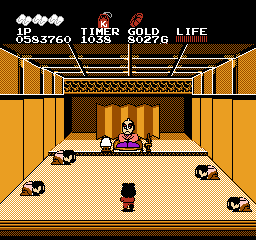

…but Goemon 2 does all this much, much better.
3) Ganbare Goemon 2 (1989) (NES)
It’s the same game, but not really! It’s got some bosses this time around, faux side-scrolling sections, and the world is riddled with signs to tell you where you are so you won’t get frustratingly lost. Now needing three passes to get to the next area feels less like an arbitrary ‘game task’ and more like making progress on a journey. This “going on a journey” feeling is one of the strongest elements of the series to me, and I’m very glad to see it’s been important since jump. Plus I’ve mentioned it for every other game so far.
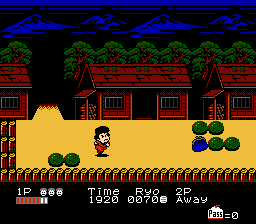



This game is also the first appearance of the rat-burgler Ebisumaru in the series, and the first game with simultaneous 2 player coop. Ebisumaru seems to help bring the goofy-cute comedic element up a notch, being an overweight pervert. The plot is, while sitting in jail bored after getting caught, Ebisumaru shows up tells Goemon about a Mechanical Castle with a great treasure inside. That’s all Goemon needed to hear for enough motivation to bust out of prison and trek across all of Japan. It’s also seemingly the only game in the series without a subtitle outside of the arcade game.

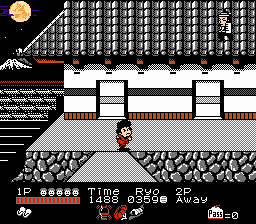


This game is really lovely. I love the colors, I love the creative use and reuse of the tiles, I love that they moved the HUD to the bottom of the screen instead of the top, happy all around. Who could hate that snow and those mountains? This game also added in some more scenic elements like many more NPCs in their houses just saying stuff, a peep show, and multiple options for sleeping in the Inn with a different scene playing out for each.




Overall the maps and world feels much more alive because of all this. Our journey across Japan is now more vibrant. Each region also has it’s own sets of foods, they all mechanically function the same but are there to showcase that what’s popular in Iyo is different than what’s famous in Shimono (and possibly partly, as Hawk deftly pointed out, tricking Japanese kids into a geography lesson) This game also allows you to upgrade your weapon from a pipe, to throwing a coin, and finally to firecrackers that seem to try and heat-seek their way to enemies (though don’t have much range, so the coin is the way to go)


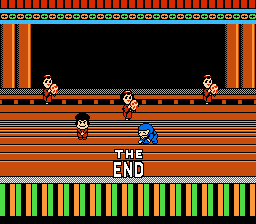
4) Ganbare Goemon Gaiden: Kieta Ōgon Kiseru (1990) (NES)
I’ve been duped! Abort, abort, it’s a traditional RPG! I didn’t sign up for this!



Luckily, Ganbare Goemon Gaiden, subtitled, “The Missing Golden Pipe”, was a pretty easy and straight forward ‘obscure rpg talk puzzle‘-wise. I don’t generally enjoy the grind of an RPG, but this one wasn’t too bad on my brainmeat. Near the end of the game I found myself having two characters, Koban and Yae, who were slightly under equipped to the point it was causing them to take a much more severe amount of damage than Goemon and Ebisumaru. We’re talking 20-40dmg vs 1dmg. This was because of my impatience of speeding through the game and not buying and trying all the armor when I’d get to a new town or find something in a cave. It was a perfect storm though, because the game doesn’t tell you who can equip what or the stats on the equipment. You’ll have to just equip something and check. This trial and error ended up too tedious for me when numbers that didn’t seem to be going up much or making much of a noticeable difference. Weeeell I was wrong, I’m often RPG wrong. Hawk had mentioned that some of these issues were likely addressed in the games manual, and he may be right. Couldn’t find a translated manual but I was looking after the fact so I didn’t look that hard. We were lucky to find a translated manual for Goemon 2 though, even though we didn’t really need it.
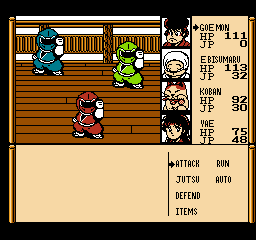
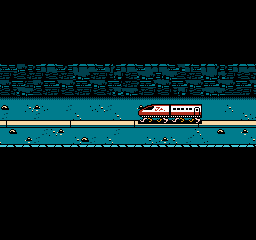

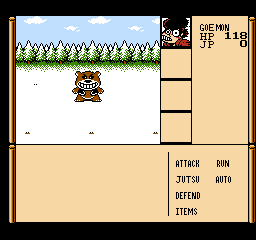
I did enjoy the overall experience though. It was cute, it was an adventure, we definitely went all over Japan again, but this time more direct in a way only an RPG with a world map could do. Hell, I’m pretty sure I saw the Great Wall of China and aliens. Coincidence? But journey or not, I never felt quite self sufficient on the journey because there was no way to raise my MP outside of towns. I could heal, revive, but not replenish. I’m not mad about this from a design perspective or anything, but it did make the little bit of grinding I did have to do feel more tedious.


I am hoping that much like how Goemon bloomed into a more beautiful game with Goemon 2, that Gaiden 2 will benefit the same way.
5) Ganbare Goemon: Yukihime Kyuushutsu Emaki (1991) (SNES)
First game on the SNES and first Goemon localized in English, under the title Legend of the Mystical Ninja. The English version changed Goemon and Ebisumaru’s name to Kid Ying and Dr. Yang, respectively. I’m very familiar with this game, having had it growing up. When my brother and I were little my grandfather got relocated to work in China for about two years. When he was back visiting once, he had gotten my brother and I two Super Nintendo games. In my brain he always “got them in China”, but looking back he definitely just got them state side. P-probably. I got Plok, and my brother got Legend of the Mystical Ninja. I’m not sure how, but he ended up being really good at picking games.
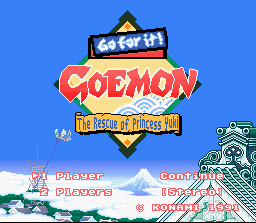



Decided to not play the localized version and stick with what I’ve been doing with fan translations, and I’m really glad I did. Having played the US version of the game so much growing up really helps make some of the differences between the two noticeable. One of the first instances of this is a gambling hut that was removed from the southern part of the first world. The US version still has the gambling in it, just not as soon as ‘the second screen of the game’ so maybe it was removed to make that aspect less apparent? Though I’ve never known Nintendo to shy away from gambling in games.
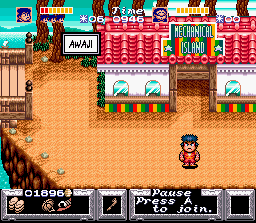


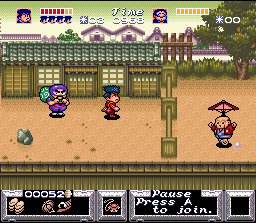
The most impactful translation difference for me comes from something much smaller though. All of the area signs around town were left in untranslated, so I never noticed how often they were changing to tell me I’d entered a different region like in the previous Goemon games. It really made the sense of scale and ‘journey around japan’ feel different to me and bigger to me. I had always assumed each World/Stage/Section was just one place, but now I’m finding out it’s supposed to be several prefectures in a region in Japan? Neat! it also made all of the different food options make more sense; it’s just the same thing the last games did to highlight regional culinary differences.



As far as differences from the previous Goemons, your weapon can upgrade 3 times again, but now it’s a wooden pipe, a golden longer pipe, and a Yo-Yo for extra reach. You can always throw coins now, no need for a power up like before, but it’s no longer free. There’s bombs at the shop that you can buy and cycle to, but they’d often get me into trouble since I’d so rarely have them, causing me to throw them on accident while thinking I was cycling back to my pipe.

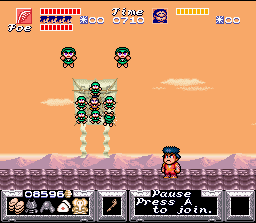


I love this game, I admit my biases here. This game is why I’m Goemon-ing now. Getting to replay it was a highlight I was looking forward to. It’s also a game I view as “a really good coop game”, even though I’m not completely sure that’s objectively true. Still, I think of it as “a coop game”, maybe since I didn’t know of a lot of good ones at the time I was playing it. Having that view though, I can’t remember the last time I actually sat down and played the game through single-player. Boy, is this game a whole lot easier by yourself. It’s nice to only have to worry about money to deck out yourself instead of you and your brother.



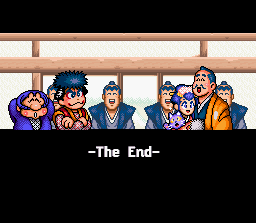
Alright, more on this in however-long-it-takes-me-to-beat-5-more-games time!
